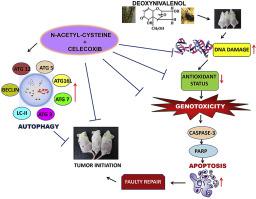Free Radical Biology and Medicine ( IF 7.1 ) Pub Date : 2020-06-17 , DOI: 10.1016/j.freeradbiomed.2020.06.001 Sakshi Mishra 1 , Aman Divakar 1 , Sonal Srivastava 1 , Jayant Dewangan 1 , Divyansh Sharma 1 , Somya Asthana 2 , Swati Chaturvedi 3 , Muhammad Wahajuddin 3 , Sadan Kumar 4 , Srikanta Kumar Rath 1

|
Deoxynivalenol is a trichothecene mycotoxin which naturally contaminates small grain, cereals intended for human and animal consumption. Investigations for dermal toxicity of DON has been needed and highlighted by WHO. Previous studies on dermal toxicity suggest that DON has DNA damaging potential leading to skin tumor initiation in mice skin. However, considering its toxicological manifestations arising after dermal exposure, strategies for its prevention/protection are barely available in literatute. Collectively, our study demonstrated that N-acetylcysteine (NAC), precursor of glutathione, significantly alters the genotoxic potential of DON. Further NAC in combination with Celecoxib (CXB) inhibits tumor growth by altering antioxidant status and increasing autophagy in DON initiated Swiss mice. Despite the broad spectrum use of CXB, its use is limited by the concerns about its adverse effects on the cardiovascular system. Serum parameters and histology analysis revealed that CXB (2 mg) when applied topically for 24 weeks did not impart any cardiovascular toxicity which could be because skin permeation potential of CXB was quite low when analyzed through HPLC analysis.
Although the anticancer effects of CXB and NAC have been studied, however, the combination of NAC and CXB has yet not been explored for any cancer treatment. Therefore our observations provide additional insights into the therapeutic effects of combinatorial treatment of CXB and NAC against skin tumor prevention. This approach might form a novel alternative strategy for skin cancer treatment as well as skin associated toxicities caused by mycotoxins such as DON. This combinatorial approach can overcome the limitations associated with the use of CXB for long term as topical application of the same seems to be safe in comparison to the oral mode of administration.
中文翻译:

N-乙酰半胱氨酸与塞来昔布的组合通过诱导瑞士小鼠的自噬途径来抑制脱氧雪腐酚诱导的皮肤肿瘤的发生。
脱氧雪腐烯酚是一种单端孢霉菌真菌毒素,自然污染小颗粒,谷物,供人类和动物食用。世卫组织需要并着重调查了呕吐毒素的皮肤毒性。先前对皮肤毒性的研究表明,DON具有破坏DNA的潜力,可导致小鼠皮肤中皮肤肿瘤的发生。但是,考虑到其在皮肤暴露后产生的毒理学表现,其预防/保护策略在文盲中几乎没有。总体而言,我们的研究表明,谷胱甘肽的前体N-乙酰半胱氨酸(NAC)可以显着改变DON的遗传毒性。进一步的NAC与Celecoxib(CXB)组合可通过改变抗氧化剂状态和增加DON引发的瑞士自噬来抑制肿瘤生长老鼠。尽管CXB的用途广泛,但由于担心其对心血管系统的不良影响,其使用受到限制。血清参数和组织学分析表明,当局部使用CXB(2 mg)24周时,不会产生任何心血管毒性,这可能是因为通过HPLC分析分析时,CXB的皮肤渗透潜能很低。
尽管已经研究了CXB和NAC的抗癌作用,但是,尚未探索将NAC和CXB的组合用于任何癌症治疗。因此,我们的观察结果为CXB和NAC联合治疗预防皮肤肿瘤提供了更多见解。这种方法可能形成皮肤癌治疗以及由真菌毒素(例如DON)引起的皮肤相关毒性的新的替代策略。这种组合方法可以克服与长期使用CXB有关的局限性,因为与口服方式相比,局部使用CXB似乎更安全。











































 京公网安备 11010802027423号
京公网安备 11010802027423号